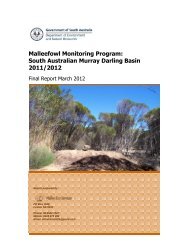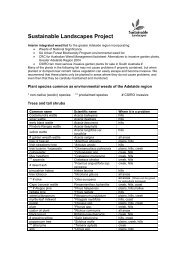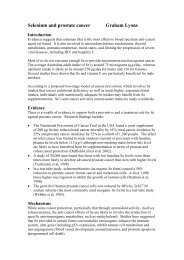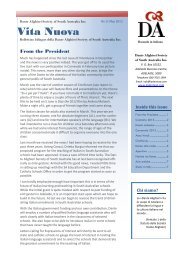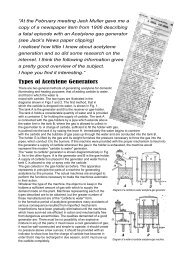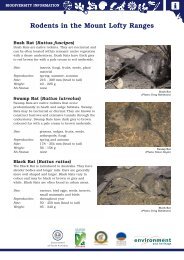The Therapeutic Design of Environments for ... - The Gerontologist
The Therapeutic Design of Environments for ... - The Gerontologist
The Therapeutic Design of Environments for ... - The Gerontologist
Create successful ePaper yourself
Turn your PDF publications into a flip-book with our unique Google optimized e-Paper software.
Copyright 2000 by<strong>The</strong> Gerontological Society <strong>of</strong> America<strong>The</strong> <strong>Gerontologist</strong>Vol. 40, No. 4, 397–416<strong>Design</strong> <strong>of</strong> the physical environment is increasingly recognized as an important aid in caring<strong>for</strong> people with dementia. This article reviews the empirical research on design anddementia, including research concerning facility planning (relocation, respite and day care,special care units, group size), research on environmental attributes (noninstitutionalcharacter, sensory stimulation, lighting, safety), studies concerning building organization(orientation, outdoor space), and research on specific rooms and activity spaces (bathrooms,toilet rooms, dining rooms, kitchens, and resident rooms). <strong>The</strong> analysis reveals major themesin research and characterizes strengths and shortcomings in methodology, theoreticalconceptualization, and applicability <strong>of</strong> findings.Key Words: Architecture, Alzheimer’s disease, Nursing homes, Assisted living<strong>The</strong> <strong>The</strong>rapeutic <strong>Design</strong> <strong>of</strong> <strong>Environments</strong> <strong>for</strong>People With Dementia: A Review <strong>of</strong> theEmpirical ResearchKristen Day, PhD, 1 Daisy Carreon, BA, 2 and Cheryl Stump, BA 31Address correspondence to Dr. Kristen Day, Department <strong>of</strong> Urban andRegional Planning, School <strong>of</strong> Social Ecology, University <strong>of</strong> Cali<strong>for</strong>nia, Irvine,CA 92967. E-mail: kday@uci.edu2Department <strong>of</strong> Sociology, University <strong>of</strong> Cali<strong>for</strong>nia, Irvine.3Department <strong>of</strong> Psychology and Social Behavior, University <strong>of</strong> Cali<strong>for</strong>nia,Irvine.<strong>Design</strong> <strong>of</strong> the physical environment is increasinglyrecognized as an important aid in the care <strong>of</strong> peoplewith Alzheimer’s disease and other dementias. Facilityadministrators and designers now view the design<strong>of</strong> long-term care, assisted living, and other environmentsas more than simply decorative. <strong>Design</strong> is regardedas a therapeutic resource to promote wellbeingand functionality among people with dementia.This article reviews and analyzes findings fromempirical research on the therapeutic impacts <strong>of</strong> designin dementia care settings.Since the early 1980s, numerous “design guides”—books and articles <strong>of</strong>fering planning, architectural,and interior design recommendations—have beenwritten to instruct architects and care providers onhow to enhance safety, homelikeness, and so <strong>for</strong>th indementia care facilities. At least four books <strong>of</strong> designguidance <strong>for</strong> dementia environments have been publishedto date (see Brawley, 1997; Calkins, 1988; Cohen& Day, 1993; Cohen & Weisman, 1991), alongwith numerous articles in scholarly and pr<strong>of</strong>essionalbooks and journals (see Appendix A, Note 1). <strong>Design</strong>recommendations <strong>for</strong> dementia environments are organizedon a continuum by scale, as follows (afterCohen & Weisman, 1991): (a) planning principles—broad decisions made when developing a dementiacare facility (e.g., facility planning should accommodatea continuum <strong>of</strong> care); (b) general attributes—desired qualities <strong>of</strong> the overall environment <strong>of</strong> the facility(e.g., facility design should promote noninstitutionalcharacter); (c) building organization—desiredarrangement <strong>of</strong> spaces within the facility (e.g., buildingdesign should support residents’ sense <strong>of</strong> orientation);and (d) specific rooms and activity spaces—thedesign <strong>of</strong> particular rooms within the facility (e.g., design<strong>of</strong> bathrooms should preserve residents’ dignityand privacy).<strong>Design</strong> guides typically <strong>of</strong>fer “hypotheses” <strong>for</strong> howthe spatial organization and appointment <strong>of</strong> the physicalenvironment may promote well-being <strong>for</strong> peoplewith dementia. For example, to minimize the sensoryoverstimulation that afflicts many people with dementia,design guides recommend modifications suchas designation <strong>of</strong> quiet rooms with s<strong>of</strong>t colors, elimination<strong>of</strong> unnecessary clutter, and removal <strong>of</strong> pagingsystems (cf. Brawley, 1997; Cohen & Weisman, 1991).Frequently, design guidance is based on the practicalexperience <strong>of</strong> designers or facility administrators; othertimes, design guidance is research based, applyingfindings from clinical research on dementia in the<strong>for</strong>m <strong>of</strong> design “solutions” (Weisman, Calkins, & Sloane,1994).Not all design guidance requires empirical researchfindings to justify its recommendations. For instance,design guides frequently call <strong>for</strong> enhancedquality <strong>of</strong> life in institutional settings (e.g., designstrategies to increase homelikeness and autonomy <strong>for</strong>residents). Such values—essential qualities <strong>of</strong> dignity,privacy, and so <strong>for</strong>th—are arguably “inalienablerights” (Lawton, 1981, p. 245) that do not requireempirical research <strong>for</strong> validation.Vol. 40, No. 4, 2000397
Other design guidance does demand verificationthrough empirical research, however. Empirical researchis needed to resolve situations in which conflictingdesign recommendations are <strong>of</strong>fered. Researchis also warranted when recommended designsolutions are <strong>of</strong> unknown effectiveness or when designrecommendations have major or controversialimpacts <strong>for</strong> cost or quality <strong>of</strong> life. Research on designand dementia has been conducted in earnest since atleast 1980, yet findings <strong>of</strong> many studies remain unknownamong designers and facility administrators.In the following sections, we review and analyze existingstudies <strong>of</strong> design and well-being <strong>for</strong> peoplewith dementia to enhance the design <strong>of</strong> dementia facilitiesand to provide direction <strong>for</strong> future research.MethodsSeveral strategies were used to identify potentialstudies <strong>for</strong> review. <strong>The</strong> first involved a key-wordsearch <strong>of</strong> four major databases: Psych Abstracts,Medline, MAGS, and CAT (see Appendix A, Note 2).Potential studies were also identified by reviewing allissues (1980 or later) <strong>of</strong> several journals in gerontologyand environment-design research (see AppendixA, Note 3). Finally, reference lists were inspected <strong>for</strong>all studies included in this review. In each case, articles,books, and chapters identified as potentially relevant(by title and by abstract if available) were collectedand assessed <strong>for</strong> appropriateness.Studies included in this review met the followingcriteria: a report <strong>of</strong> empirical research (see AppendixA, Note 4), published 1980 or later (see Appendix A,Note 5), written in English, with an emphasis on peoplewith dementia or their families or staff caregivers,and with a substantial (though sometimes secondary)emphasis on the relationship between the design <strong>of</strong>the physical environment and the well-being <strong>of</strong> peoplewith dementia, their families, and/or staff. For thisreview, the physical environment was loosely definedas the domain <strong>of</strong> relevance to architects, interiordesigners, facility managers, and/or administratorsor caregivers undertaking environmental designor renovation. Thus, research on issues such as lighting,furnishings, and outdoor space was included.Research on microscale “product” design (e.g., prostheticdevices to facilitate eating) or on the sensory orsocial environment outside the purview <strong>of</strong> designers(e.g., incorporation <strong>of</strong> music and pets) was excluded, aswere studies that did not examine actual environmentsor actual impacts. Well-being was defined broadly, toinclude factors such as residents’ activities <strong>of</strong> daily living(ADL), physical well-being, cognitive function, andproblem behaviors; family members’ well-being; andstaff well-being and job per<strong>for</strong>mance. Seventy-one researchreports were included in the review. Because <strong>of</strong>this selective search strategy, we may have overlookedsome relevant material in the review.Research <strong>Design</strong> and Sample SizeMuch research on design and dementia comprisessmall size samples. For example, more than 30% <strong>of</strong>the studies reviewed used samples <strong>of</strong> fewer than 30participants; many included less than 10 participants.Sample sizes reflect the limited populations <strong>of</strong> residentsat the single facility in which many studieswere conducted, the high rates <strong>of</strong> resident mortality,and facilities’ limited populations <strong>of</strong> residents incomparable stages <strong>of</strong> dementia. Although they raiseconcern <strong>for</strong> the validity and generalizability <strong>of</strong> findings,studies with small samples were included so asnot to severely restrict the scope <strong>of</strong> this review. Researchdesigns and samples are described in Table 1.Results<strong>The</strong> rate <strong>of</strong> research on design and dementia is increasing:from 6 research reports from 1981–1985, to17 research reports from 1986–1990, to 26 researchreports from 1991–1995, and to 21 research reportsalready published since 1996 (see Table 1). This sectionsummarizes findings from the research reportsreviewed, according to the organizational frameworkpresented earlier (i.e., planning principles, general attributes<strong>of</strong> the environment, building organization,and specific rooms and activity spaces). <strong>The</strong> summaryis followed by a discussion and analysis <strong>of</strong> existingresearch on design and dementia.Planning Principles<strong>The</strong>se studies examine broad decisions regardingthe development <strong>of</strong> dementia care settings. Studiesexamined impacts <strong>for</strong> well-being following relocation<strong>of</strong> people with dementia to new environments,use <strong>of</strong> respite and day care environments and <strong>of</strong> specialcare units (SCUs), and exposure to various groupsizes <strong>of</strong> residents.Relocation to New <strong>Environments</strong>.—Findings aremixed regarding the impacts <strong>of</strong> relocating peoplewith dementia to new environments (Robertson,Warrington, & Eagles, 1993; Seltzer et al., 1988; seeAppendix A, Note 6). When moved together as intactunits <strong>of</strong> residents and staff, people with dementia appearto suffer few or no adverse impacts from relocation(Anthony, Procter, Silverman, & Murphy, 1987;McAuslane & Sperlinger, 1994; Robertson et al.,1993). <strong>The</strong> more pleasant environment <strong>of</strong> a new facilitymay partially explain the lack <strong>of</strong> negative impact<strong>for</strong> relocated residents (according to McAuslane& Sperlinger, 1994). In contrast, residents with dementiawho are moved individually appear to sufferhigher rates <strong>of</strong> depression and mortality following relocation(Anthony et al., 1987; Robertson et al.,1993). This effect holds when residents undergo orientationto ease relocation. Staff members also reportdecreased job satisfaction (attributed to anxiety) priorto moving, which returns to premove levels <strong>of</strong> satisfactionfollowing relocation (McAuslane & Sperlinger,1994).Respite <strong>Environments</strong>.—Respite environments <strong>of</strong>fertemporary care <strong>for</strong> people with dementia and providerelief to families. <strong>The</strong> impacts <strong>of</strong> respite environ-398 <strong>The</strong> <strong>Gerontologist</strong>
StudyConcept <strong>of</strong>environment a ;Focus <strong>of</strong> studyCohen-Mansfield,Werner, & Marx(1990)Dickinson, McLain-Kark, & Marshall-Baker (1995)Discrete; ProblembehaviorsDiscrete; <strong>Design</strong>featuresElmståhl, Annerstedt,& Åhlund (1997)Discrete; <strong>Design</strong>featuresGötestam & Melin(1987)Discrete: <strong>Design</strong>featuresGreene, Asp, & Crane(1985)Global;EnvironmentalcomparisonHanley (1981) Discrete; ProblembehaviorsHolmes, Teresi,Weiner, Monaco,Ronch, & Vickers(1990)Global;EnvironmentalcomparisonHussian (1982/83) Discrete; ProblembehaviorsHussain & Brown(1987)Discrete: <strong>Design</strong>featuresHutchinson, Leger-Krall, & Wilson(1996)Discrete; ProblembehaviorsJones (1998) Global;EnvironmentalcomparisonTable 1. Summary <strong>of</strong> Key In<strong>for</strong>mation on the Studies Reviewed on <strong>Design</strong> and Dementia (Continued )ResearchdesignSamplein<strong>for</strong>mationOutcomemeasures <strong>of</strong>well-beingPhysicalenvironmentfeaturesMajor finding(s) <strong>of</strong>environmentalimpacts onwell-beingSurvey 24 residents in long-term carefacilityResidents’ agitation Location in the unit Agitation <strong>of</strong> residents was associatedwith residents’ location in the unit.One grouppretest/posttestQuasiexperiment7 residents in SCU Residents’ exit attempts Alarmed emergency exit doors,with closed miniblinds overwindows, cloth cover overpanic bar105 residents in group living units Residents’ confusion, disorientation Building layouts, amount <strong>of</strong>space, lighting, noise, size <strong>of</strong>hallways, homelikeappearance and furnishingsExperiment 21 residents in psychogeriatricward (19 with dementia)One grouppretest/posttestLongitudinalstudyExperimentand quasiexperimentQuasiexperimentQuasiexperimentEthnographicstudyResidents’ eating behavior, communication, activity levels Noninstitutional diningarrangements (dining in c<strong>of</strong>feeroom at small tables with familystyle service, bright lights)12 residents in SCU Residents’ hostility, agitation, appetite, self-feeding,combativeness, ambulation, incontinence, dressing,cognitive skills, withdrawal, hallucinations6 residents in psychogeriatricward2 residents in “old people’shome”120 residents in skilled nursingfacilities79 residents in health relatedfacilities49 residents in SCUs3 residents in long-term carefacility8 residents in public mentalhospitalClients with dementia in day careprogram c16 relativesSCU: single and double rooms,locked doors, personalization,music, dining areaResidents’ orientation ability Large, 3-D ward signs and largepictorial signsResidents’ cognitive ability, depression, arousal, orientation,behaviors, ambulation, mood, activity limitation, familycontacts, activity participation, ADLs, satisfaction withthe environment, medical symptoms, sleeping, safetyprecautions, social activitiesSCUs: locked exit with alarm,rounded edge furnishings,dining set up <strong>for</strong> optionalfeeding <strong>of</strong> residents, specialactivity rooms, staff deskplaced to monitor egressResidents’ exit attempts Supernormal stimuli (i.e.,brightly colored cardboardshapes)Residents’ exit attempts Tape grids on the floor in front <strong>of</strong>exit doorsResidents’ toileting behavior and issuesRelatives’ perceptions <strong>of</strong> resident toileting issuesNumber, size, and design <strong>of</strong>toilet roomsVisual barriers significantly reducedresidents’ exit attempts.Resident orientation was associatedwith group living unit design thatfacilitates perception withoutreducing ”communication area.”Noninstitutional dining arrangementsimproved eating behavior andcommunication among residents.SCU was associated withimprovements in residents’behavior, cognitive skills, andaffective responses.Signs improved residents’ orientation,when used in combination withorientation trainingSCUs were not associated withsignificant impacts on residents’functional and cognitive status.Conditioning residents to respond tostimuli reduced residents’ exitattempts.Tape grid barriers in front <strong>of</strong> exitdoors reduced residents’ exitattempts.Ease <strong>of</strong> toileting was associated withincreased number and size <strong>of</strong>bathrooms.Crosssectionalsurvey13 day care staff members29 staff members in two geriatricpsychiatry unitsStaff perceptions <strong>of</strong> resident toileting issuesStaff attitudes, morale High stimulation environment,with sociopetal furniturearrangement, recreationalmaterials, orientation aids(mirrors, clocks, signposts,reality orientation boards)Morale was higher among staffworking in a high stimulationenvironment (i.e., orientation aids,recreational materials, realityorientation programs) comparedwith staff in a traditional ward.(Table continues on next page)400 <strong>The</strong> <strong>Gerontologist</strong>
StudyConcept <strong>of</strong>environment a ;Focus <strong>of</strong> studyKihlgren, Bråne,Karlsson,Kuremyr, Leissner,& Norberg (1992)Global;EnvironmentalcomparisonKoss & Gilmore(1998)Discrete; <strong>Design</strong>featuresKovach & Meyer-Arnold (1996)Discrete; ProblembehaviorsLawton, Liebowitz, &Charon (1970)Global;EnvironmentalcomparisonLawton, Fulcomer, &Kleban (1984)Global &discrete;EnvironmentalcomparisonLovell, Ancoli-Israel,& Gevirtz (1995)Discrete; <strong>Design</strong>featuresLyman (1989) Global;EnvironmentalcomparisonMayer & Darby(1991)McAllister &Silverman (1999)Discrete; <strong>Design</strong>featuresGlobal;EnvironmentalcomparisonsTable 1. Summary <strong>of</strong> Key In<strong>for</strong>mation on the Studies Reviewed on <strong>Design</strong> and Dementia (Continued )ResearchdesignSamplein<strong>for</strong>mationOutcomemeasures <strong>of</strong>well-beingPhysicalenvironmentfeaturesMajor finding(s) <strong>of</strong>environmentalimpacts onwell-beingQuasiexperimentQuasiexperimentCrosssectionalsurveyQuasiexperimentPostoccupancyevaluation5 residents in collective living Residents’ mental and somatic health: orientation, motorhomefunctions, vision, hearing, speech, ADLs, behavioral5 residents <strong>of</strong> nursing home disturbance, work load, psychiatric symptomsrelatives cPerceptions <strong>of</strong> residents, residents’ livingstaff c13 residents in dementia unit Residents’ amount <strong>of</strong> food intake, amount <strong>of</strong> help neededeating, agitation18 residents in SCU15 clients in day care program9 original residents in long-termcare,6 new residents (including oneoriginal) in SCU56 residents in SCU134 relatives <strong>of</strong> long-term careresidents86 relatives <strong>of</strong> SCU residents80 staff members in long-termcare unit60 staff members in SCU6 residents in skilled nursingfacilityResidents’ behavior (especially agitation) during bathing,caregiver behavior during bathingResidents’ mental status, number <strong>of</strong> personnel present, staffto-residentinteraction, resident-to-resident interaction,self-maintaining behavior, active interest, location <strong>of</strong>resident, excursions <strong>of</strong>f unitResidents’ location and social behaviorRelatives’ assessment <strong>of</strong> old and new buildingStaff assessment <strong>of</strong> old and new buildingCollective living home: separateapartments with ownfurniture, rooms <strong>for</strong> commonactivitiesIncreased light intensity, highcontrast tablecloth, placemats, dishes, and so <strong>for</strong>th <strong>for</strong>diningPhysical features in and outsidethe bathroom that impactbathing, tubs versus showersSCU: private rooms,noninstitutional design(bright colors, pattern, birdnoises, planter, space <strong>for</strong>personal belongings), definedsocial spaceSCU: bright room decor, colorcoding, graphics, largeorienting stimuli, largecentral areaResidents in collective livingdemonstrated better social abilities,more alertness, reduced depression,and more disturbances, than didresidents in a nursing home. Staffwere more accepting <strong>of</strong> residents’behavior in collective living than innursing home.Heightened contrast and increasedlight were associated withincreased food eaten and reducedagitation among residents.Environmental (and other) features areassociated with increased agitationduring bathing.SCU was associated with decreasedpersonal interactions, decreasedself-maintaining behavior,increased mobility, and increasedrange <strong>of</strong> behavior among residents.SCU design was associated withincreased therapeutic impact,decreased pathological behaviors,and decreased self-maintenancebehaviors among residents. SCUdesign was associated withincreased visits from relatives.Residents’ agitation Exposure to bright light Exposure to bright light reducedresident agitation, with greatestimpacts on residents in mid- tolate-stage dementia.QuasiexperimentQuasiexperimentQuasiexperimentEthnographicstudystaff at day care center <strong>for</strong> dementiaand nondementia clients c Staff stress and quality <strong>of</strong> caregiving enhanced facility (safety andRelocation <strong>of</strong> day care center tosurveillance features,enclosed garden, therapyrooms)9 residents in psychogeriatricwardPopulation <strong>of</strong> personal care home<strong>of</strong> 59 residents,8 residents in personal care home8 residents in nursing homeResidents’ exit attempts Placement <strong>of</strong> mirror, reversemirror in front <strong>of</strong> exit doorResidents’ experience <strong>of</strong> community, participation inactivities, social networks and relationships, rolesPersonal care home: smallgroups <strong>of</strong> residents, privaterooms, kitchenette, diningroom, living room, patio,wandering path and commonroomsRelocation <strong>of</strong> day care center toenhanced facility was associatedwith positive and negative changesin the nature <strong>of</strong> staff stress andquality <strong>of</strong> care.Mirror in front <strong>of</strong> exit door reducedresidents’ exit attempts.Personal care home was associatedwith increased residentresponsiveness to the environmentand with community building.(Table continues on next page)Vol. 40, No. 4, 2000401
StudyConcept <strong>of</strong>environment a ;Focus <strong>of</strong> studyMcAuslane &Sperlinger (1994)Global;Environmentalservices &policiesMcCracken &Fitzwater (1989)Melin & Götestam(1981)Global;EnvironmentalcomparisonDiscrete; <strong>Design</strong>featuresMishima, Okawa,Hishikawa,Hozumi, Hori, &Takahashi (1994)Moony & Nicell(1992)Discrete; <strong>Design</strong>featuresDiscrete; <strong>Design</strong>featuresMoore (1999) Global; Impliedenvironmentalcomparison(though onecase only)Morgan & Stewart(1999)Discrete; <strong>Design</strong>featuresMorgan & Stewart(1998)Discrete; <strong>Design</strong>featuresNamazi & Johnson(1996)Discrete; ProblembehaviorsNamazi & Johnson(1992a)Discrete; <strong>Design</strong>featuresNamazi & Johnson(1992b)Discrete; <strong>Design</strong>featuresNamazi & Johnson(1992c)Discrete; <strong>Design</strong>featuresTable 1. Summary <strong>of</strong> Key In<strong>for</strong>mation on the Studies Reviewed on <strong>Design</strong> and Dementia (Continued )ResearchdesignSamplein<strong>for</strong>mationOutcomemeasures <strong>of</strong>well-beingPhysicalenvironmentfeaturesOne grouppretest/posttest15 residents relocated tocommunity nursing home12 residents remaining inpsychogeriatric ward16 relocated staff19 staff not relocatedResidents’ behavioral dependence, problem behaviorsStaff job satisfaction11 residents in SCU Residents’ behavior (language, social interaction, attention,orientation, motor coordination, incontinence, eating,dressing, and grooming)Experiment 21 residents in psychogeriatricward (19 with dementia)Relocation from apsychogeriatric ward to acommunity nursing homeOpen versus closed dementiaunitResidents’ eating behavior, communication Noninstitutional diningarrangementsExperiment 14 residents in psychogeriatricward10 residents without dementia inpsychiatric hospitalLongitudinalstudyResidents in five SCUs (each with25–31 residents)Residents’ sleep time, behavior disorders, melatoninsecretion levelsResidents’ incidents (falls, injuries, aggression, missing,other), time spent outdoorsExposure to morning bright lighttherapy<strong>The</strong>rapeutic and traditionaloutdoor environmentsEthnography 22 residents in SCUQuasiexperimentCrosssectionalsurveyLongitudinalstudyStaff in SCU9 relatives <strong>of</strong> residents relocatedfrom high to low density SCU9 relocated staff members39 residents relocated from onehigh density long-term careunit to another14 residents relocated from highdensity long-term care to lowdensity SCUs11 residents remaining in highdensity unit22 residents in SCU12 primary care staff in SCUResidents’ experience <strong>of</strong> dining, social interaction,homelikeness, interactions with staffStaff behavior and attitudes towards residentsRelatives’ assessment <strong>of</strong> buildings, perceptions <strong>of</strong> densityand <strong>of</strong> private roomsStaff assessment <strong>of</strong> buildings, perceptions <strong>of</strong> density and <strong>of</strong>private roomsSCU: small group size; clustereddining and living rooms,kitchen; wandering area, viewsto outdoors, day light, religiouscorner, common areasLow density SCU: small groupsize, overall facility size,private rooms and bathroomsResidents’ disruptive and nondisruptive behavior Group size, overall facility size,private rooms and bathroomsResidents’ bathing habits; bathing safety; bathing problembehavior, especially aggression and agitationStaff perceptions <strong>of</strong> bathing and bathing problemsBathing environment andequipmentOne-shot casestudyintervention8 residents in SCU Residents’ ability to dress independently, staff assistance indressing22 residents in SCU Residents’ independent selection <strong>of</strong> snacks and snackingchoicesCloset modification: presentsonly clothes to be worn, inappropriate orderGlass-door and dormitory-stylerefrigerators with snacks, inresident kitchensQuasiexperimentQuasiexperimentQuasiexperiment22 residents in SCU Residents’ agitation levels, exiting behavior Unlocking door to secureoutdoor areaMajor finding(s) <strong>of</strong>environmentalimpacts onwell-beingRelocated residents showed noevidence <strong>of</strong> changes in behavioraldependency or in the number <strong>of</strong>problem behaviors. Staff initiallyreported increased jobdissatisfaction prior to relocation.Closed SCU was associated withimproved functioning amongresidents.Noninstitutional dining arrangementsimproved eating behavior andcommunication among residents.Exposure to bright light increasedresidents’ total and night sleeptime, reduced day sleep time, andreduced behavior disorders.Use <strong>of</strong> outdoor environments reducedincidents and aggressive behavioramong residents.SCU was associated with enhancedsocial interaction and friendship<strong>for</strong>mation among residents, butorganizational and physical factorsin SCU limit therapeutic potential.Small group size, small facility size,and private residents rooms <strong>of</strong> SCUwere evaluated as positivefeatures.Residents relocated to low densitySCU displayed improvements indisruptive and nondisruptivebehavior.Institutional tub was associated withresident apprehension andresistance, and is regarded asunfamiliar.Closet modifications enhancedresidents’ independence indressing.Neither visible nor accessiblerefrigerators greatly increased theincidences <strong>of</strong> independentsnacking among residents.Free access to a secure outdoor areadecreased residents’ agitatedbehavior.(Table continues on next page)402 <strong>The</strong> <strong>Gerontologist</strong>
StudyConcept <strong>of</strong>environment a ;Focus <strong>of</strong> studyNamazi & Johnson(1992d)Discrete; <strong>Design</strong>featuresNamazi & Johnson(1991a)Namazi & Johnson(1991b)Discrete; <strong>Design</strong>featuresDiscrete; <strong>Design</strong>featuresNamazi, Rosner, &Calkins (1989)Discrete; <strong>Design</strong>featuresNamazi, Rosner, &Rechlin (1991)Discrete; <strong>Design</strong>featuresNegley & Manley(1990)Discrete; <strong>Design</strong>featuresNelson (1995) Discrete; ProblembehaviorsNetten (1993) Discrete; Bothdesignfeatures andproblembehaviorsNetten (1989) Discrete; ProblembehaviorsPassini, Rainville,Marchand, &Joanette (1998)Discrete; ProblembehaviorsPhillips et al., (1997) Global;EnvironmentalcomparisonPynoos & Ohta(1991)Discrete; <strong>Design</strong>featuresRobertson,Warrington, &Eagles (1993)Global;Environmentalservices &policiesTable 1. Summary <strong>of</strong> Key In<strong>for</strong>mation on the Studies Reviewed on <strong>Design</strong> and Dementia (Continued )ResearchdesignSamplein<strong>for</strong>mationOutcomemeasures <strong>of</strong>well-beingPhysicalenvironmentfeatures12 residents in SCU Residents’ distractions and focus on task Cloth barriers used to createactivity areasExperiment 14 residents in SCU Residents’ frequency and appropriateness <strong>of</strong> toilet use Curtains surrounding toilet inlieu <strong>of</strong> doors44 residents in two SCUs Residents’ ability to locate and use the toilet Signage with various words,symbols to indicate “toilet”9 residents in SCU Residents’ exit attempts Tape grids in front <strong>of</strong> exit doors,cloth cover over panic bar,disguise <strong>of</strong> door knob (paint,knob cover)Experiment 10 residents in SCU Residents’ identification <strong>of</strong> their rooms Display cases outside residents’rooms, with and withoutpersonally meaningfulmemorabiliaResidents in 47-bed SCU Residents’ assaultive behavior Relocation <strong>of</strong> dining to two dayrooms on dementia unitEthnographicstudyLongitudinalstudyQuasiexperimentQuasiexperimentQuasiexperimentQuasiexperimentCrosssectionalsurveyResidents in59-bed skilled nursing facility79 residents in 13 residential carehomes104 residents in 6 group homesand 7 communal homesExperiment 14 people with dementia28 healthy older adultsResidents’ disruptive behavior Environmental stressors,including loud noise, crowds<strong>of</strong> people, frightening images,entertainmentResidents’ apathy, social disturbance, orientation,discontentedness, agitation, smilingAccess to outdoors, privatespace, personalization, light,quiet, territoriality, privaterooms, room size, roomchangesResidents’ wayfinding ability Building complexity, decisionpoints, number <strong>of</strong> zones,color coding, signageResidents’ spatial orientation, wayfinding Building configuration,environmental in<strong>for</strong>mationCrosssectionalsurveyEvaluationresearchQuasiexperiment77,337 residents in 841 SCUs andnursing homes in four states12 caregivers <strong>of</strong> people withdementia, at home73 residents in psychogeriatricwards relocated as intact units47 residents in psychogeriatricwards relocated individuallyResidents’ functional status, weight, ADL function,cognitive per<strong>for</strong>mance, behavior problemsSCUs: Overall environmentalquality, includingcleanliness, homelikeness,lighting, stimulationRelatives’ evaluation <strong>of</strong> effectiveness <strong>of</strong> modifications Home modifications, includinghandrail, reality orientationboard, raised toilet seat, bidet,grab bar, bath modicationsResidents’ mortality Relocation <strong>of</strong> residents as unitsor individuallyMajor finding(s) <strong>of</strong>environmentalimpacts onwell-beingEnvironmental barriers wereassociated with reduced visual andauditory distractions and increasedfocus in attention among residents.Visual access to toilets increasedresidents’ use <strong>of</strong> toilets.Verbal and pictorial signageincreased residents’ ability tolocate the toilet.Cloth covers on door knobsdecreased residents’ exit attempts.Display cases with meaningfulmemorabilia increased residents’identification <strong>of</strong> rooms.Residents’ assaultive behaviordecreased following relocation <strong>of</strong>dining to the dementia unit.Residents’ assaultive behavior wasassociated with environmentalstressors.Environmental features wereassociated with orientation, socialdisturbance, apathy, anddiscontentedness among residents.Building configuration and type <strong>of</strong>facility were associated withorientation among residents.Simple building configuration andexplicit environmentalin<strong>for</strong>mation were associated withresident orientation.Functional decline rates <strong>for</strong> SCUresidents were comparable tothose <strong>for</strong> non-SCU residents.Nine months after adoption, mosthome modifications wereevaluated by relatives as stilleffective.Relocation was associated withincreased mortality <strong>for</strong> residentswho were relocated individually.(Table continues on next page)Vol. 40, No. 4, 2000403
StudyConcept <strong>of</strong>environment a ;Focus <strong>of</strong> studySatlin, Volicer, Ross,Herz, & Campbell(1992)Discrete; <strong>Design</strong>featuresSaxton, Silverman,Ricci, Keane, &Deeley (1998)Global;EnvironmentalcomparisonScandura (1995) Discrete; ProblembehaviorsSeltzer et al., (1988) Global;Environmentalservices &policiesSkea & Lindsay(1996)Global;EnvironmentalcomparisonSloane et al., (1998) Discrete; ProblembehaviorsSwanson, Maas, &Buckwalter (1993)Global;EnvironmentalcomparisonTeresi, Holmes, &Monaco (1993)Discrete; ProblembehaviorsUlla, Johanna, &Raimo (1998)Global;EnvironmentalservicespoliciesVan Someren,Kessler, Mirmiran,& Swaab (1997)Discrete; <strong>Design</strong>featuresTable 1. Summary <strong>of</strong> Key In<strong>for</strong>mation on the Studies Reviewed on <strong>Design</strong> and Dementia (Continued )ResearchdesignSamplein<strong>for</strong>mationOutcomemeasures <strong>of</strong>well-beingPhysicalenvironmentfeaturesMajor finding(s) <strong>of</strong>environmentalimpacts onwell-beingLongitudinalstudyOne grouppretest/posttestQuasiexperimentQuasiexperimentQuasiexperimentCrosssectionalsurveyLongitudinalstudyOne grouppretest/posttestQuasiexperimentQuasiexperiment10 residents in veterans hospital Residents’ agitation, sleep patterns, restraint usage,medication usage26 residents in SCU19 residents in nursing homeResidents’ ADLs (self-care, toileting, social/cognitivefunction, mobility), cognitive impairment, problembehaviors, depression, fallsExposure to bright light Exposure to bright light wasassociated with improved sleeppatterns among residents, but notwith reduced agitation or reduceduse <strong>of</strong> restraints.SCU: cluster design, smallgroups, wandering pathresidents in SCU c Residents’ falls Special furnishings: bean bagchairs, futons, mattressesplaced on floor37 clients at dementia respitecenter in veterans hospital19 residents in communityhospital ward24 residents in partnershipscheme homes8 staff in community hospitalward12 staff in partnership schemehomesResidents in 53 SCUs in fourstates13 residents in SCU9 residents in long-term care77 cognitively intact residents inintegrated units, including 23living near residents withdementiaClients’ cognitive status, functional status (dressing, sleepingpattern, muscular rigidity, self-feeding, ambulation, jointcontractures, muteness, eye contact), language, mood,communication, social contact, cooperationResidents’ cognitive impairment, depression, self-care,mobility, communication, social functioning, quality <strong>of</strong>life on the unit (quantity and quality <strong>of</strong> interaction)Staff job satisfaction,psychological well-beingSCUs were associated with preservedmobility among residents, but notwith reduced functional decline.Special furnishings were associatedwith reduced falls amongresidents.Respite environment Respite care was associated withimproved function <strong>of</strong> lowerfunctioning residents and withslight deterioration among higherfunctioning residents.Group size, shared commonspaces, private rooms andbath rooms, controlResidents’ agitation, wandering SCUs: environmental quality,including design,maintenance, space, seating,lighting, noise, residentrooms, stimuli, unit sizeResidents’ catastrophic behavior, unscheduled interactionsand activities, wanderingCognitively intact residents’ depression, demoralization, lifedissatisfaction, living statusSCU: safe wandering, separation<strong>of</strong> dementia residents, safeand sturdy furnishingsResidential proximity <strong>of</strong>cognitively intact residents toresidents with dementia85 residents living at home Residents’ mood, functional ability, cognitive functioning SCUs: homelike environmentswith kitchens, one in familiarurban setting and one withbackyard, sauna, balcony22 patients with dementia Residents’ rest–activity rhythms Exposure to indirect (ceilingmounted)bright lightPartnership scheme homes wereassociated with enhancedcommunication skills, self-careskills, mobility, social functioning,and quality <strong>of</strong> life among residents,but not with enhanced cognitivestatus.Increased environmental quality wasassociated with reduced agitationand reduced wandering amongresidents.SCU was associated with reducedcatastrophic reactions and morespontaneous reactions amongresidents, but not with reducedwandering.Close residential proximity toresidents with dementia wasassociated with increaseddepression, demoralization, andlife dissatisfaction amongcognitively intact residents.Use <strong>of</strong> respite environments locatedin SCUs was not associated withdeterioration <strong>of</strong> residents, and wasassociated with rehabilitation <strong>for</strong>some residents.Increased exposure to bright light wasassociated with improvedcircadian rest–activity rhythmsamong residents.(Table continues on next page)404 <strong>The</strong> <strong>Gerontologist</strong>
Table 1. Summary <strong>of</strong> Key In<strong>for</strong>mation on the Studies Reviewed on <strong>Design</strong> and Dementia (Continued )StudyConcept <strong>of</strong>environment a ;Focus <strong>of</strong> studyResearchdesignSamplein<strong>for</strong>mationOutcomemeasures <strong>of</strong>well-beingPhysicalenvironmentfeaturesMajor finding(s) <strong>of</strong>environmentalimpacts onwell-beingWebber, Breur, &Lindeman (1995)Global;EnvironmentalcomparisonWells & Jorm (1987) Global;Environmentalservices &policiesWhall et al., (1997) Discrete; ProblembehaviorsWiltzius, Gambert, &Duthie (1981)Wimo, Nelvig,Adolfsson,Mattson, &Sandman (1993)Global;Environmentalservices &policiesGlobal;Environmentalcomparison12 residents in 4 SCUs10 residents in 4 skilled nursingfacilitiesrelatives c8 staff in 4 SCUs10 staff in 4 skilled nursingfacilitiesExperiment 12 residents in SCU10 residents at home using respiteand other services26 family caregivers <strong>of</strong> residentsin SCU or at home usingrespiteResidents’ cognitive functioning, behavior, problembehaviors, affect, mood, ADLs, weight, socialization,falls, activity participation, physical and pharmacologicalrestraint usage, interactionResidents’ background, dispensationStaffing patterns, training, job rewards and stressors, workhistory, interactionsResidents’ and clients’ cognitive ability, physical andperceptual skills, occupation, independent functioning,behavior problems, communicationCaregivers’ general health, anxiety, depression, quality <strong>of</strong>life, guilt, griefPrivacy, special therapeuticfeatures (wandering path,special activity areas,environmental cues)SCU placement versus homeplus respite care and otherservicesExperiment 31 residents in 5 nursing homes Residents’ aggression, agitation Natural elements (animal, bird,nature sounds and pictures,food) during bathingQuasiexperimentQuasiexperimentQuasiexperimentand survey20 cognitively intact residents Residents’ orientation, intellectual and social behavior,social interaction, sensory perception, ADLs (hygiene,sleep, nutrition, elimination, ambulation)31 residents in SCU in mentalhospital31 residents in mental hospital23 staffResidents’ orientation, ADL function, imposed work load,drug usageStaff assessment <strong>of</strong> program effectivenessIntegration or segregation <strong>of</strong>people with dementia andcognitively intact residentsSCU: familiar decorations,mirrors, signage, TV, radio,newspapers, access topersonal belongingsSCUs and skilled nursing facilitieswere associated with fewdifferences in resident outcomes orin facility/staffing characteristics.Placement <strong>of</strong> residents in SCUs wasassociated with reducedpsychological symptoms amongrelatives. Both SCUs and otheralternatives were associated withdeclines in residents’ abilities.Introduction <strong>of</strong> natural elements wasassociated with reduced agitation<strong>of</strong> residents during bathing.Integration <strong>of</strong> cognitively impairedand nonimpaired residents wasassociated with declines in mentaland emotional status <strong>for</strong>cognitively intact residents.SCU was associated with positive staffassessment. SCU and mentalhospital were associated withdeclines in residents’ ADLs,orientation, and behavior.Note: ADL activities <strong>of</strong> daily living; SCU special care unit.a Conceptualization <strong>of</strong> the physical environment—either “globally” (i.e., as a single entity, including the physical and social environment, without isolation <strong>of</strong> specific physical features) or discretely (i.e., with one or more features<strong>of</strong> the physical environment treated as variables and other aspects <strong>of</strong> the environment held constant). (Modeled after Weisman, Calkins, & Sloane, 1994.)b Unless otherwise specified, “residents” are people with dementia.c In<strong>for</strong>mation not provided.Vol. 40, No. 4, 2000405
ments on people with dementia appear to be relatedto individuals’ functional levels and to the type <strong>of</strong> environment.In an examination <strong>of</strong> 37 clients <strong>of</strong> respiteservices, Seltzer and colleagues (1988) found that,following a 2-week respite stay, lower functioning individualsshowed small improvements in ADLs, whereashigher functioning individuals showed a small declinein ADLs. Both effects were minor, and neithergroup revealed any changes in cognitive status followingrespite. In a study <strong>of</strong> 85 people with dementia,use <strong>of</strong> respite environments <strong>for</strong> approximately 2weeks was associated with little deterioration andwith improvements in cognitive function and mood(Ulla, Johanna, & Raimo, 1998). Improvements wereattributed to the therapeutic philosophy and careplan <strong>of</strong> the SCUs, and to the SCUs’ homelike environments.Thus, findings largely support the use <strong>of</strong>respite as an alternative to home care alone, becausenegative impacts <strong>of</strong> respite are limited.SCUs.—Generally, SCUs are segregated units thataccommodate only cognitively impaired individuals,such as those with dementia. SCUs distinguish themselvesby <strong>of</strong>fering one or more “special” features, includingdementia-appropriate activities, small groups<strong>of</strong> residents, special staff selection and training, familyinvolvement, and specialized design (see alsoBerg et al., 1991). According to a survey <strong>of</strong> 31 SCUsin five states, the most typical, distinguishing environmentalfeatures <strong>of</strong> SCUs (compared to nonspecializedunits) include smaller size units, fewer residentrooms, and more designated private rooms (Mathew& Sloane, 1991). SCUs are further characterized bythe presence <strong>of</strong> private dining rooms, separate andlarger activity rooms, and access to the outdoors(Mathew & Sloane, 1991).<strong>The</strong> effectiveness <strong>of</strong> SCUs <strong>for</strong> people with dementiahas been subject to debate. A complete review <strong>of</strong>this multifaceted research is beyond the scope <strong>of</strong> thisarticle, in which we focus on the physical environmentonly (<strong>for</strong> reviews, see Maslow, 1994; Teresi,Grant, Holmes, & Ory, 1998; Weisman et al., 1994).General in<strong>for</strong>mation on the impacts <strong>of</strong> SCUs warrantmention, however. Studies show associations betweenSCU environments and improvement orslowed decline in residents’ communication skills,self-care skills, social function, mobility, and affectiveresponses (Benson, Cameron, Humbach, Servino,& Gambert, 1987; Greene, Asp, & Crane, 1985; Mc-Cracken & Fitzwater, 1989; Skea & Lindesay, 1996).Additionally, SCUs are associated with reductions inbehavior disturbances, abnormal motor activity, apathy,and hallucinations among residents (Annerstedt,1993; Bellelli et al., 1998; Benson et al., 1987;Greene et al., 1985; McCracken & Fitzwater, 1989;Swanson, Maas, & Buckwalter, 1993).Other positive impacts <strong>of</strong> SCUs reported in thesestudies include reduced emotional strain among relativesand increased competence and satisfactionamong staff (Annerstedt, 1993; Wells & Jorm, 1987;see Appendix A, Note 7). Segregation <strong>of</strong> dementiaresidents into special units also appears to benefitresidents without cognitive impairments. Cognitivelyintact residents are found to suffer declines inmental and emotional status when living in closeresidential proximity to people with dementia (Teresi,Holmes, & Monaco, 1993; Wiltzius, Gambert,& Duthie, 1981).Alternately, SCUs are reported to have little or nopositive effect on residents’ wandering, cognition,functionality, and behavior, or on staff job satisfactionor job pressure (Bellelli et al., 1998; Chafetz,1991; Holmes et al., 1990; Ramírez, Teresi, Holmes,& Fairchild, 1998; Saxton, Silverman, Rica, Keane, &Deeley, 1998; Skea & Lindesay, 1996; Swanson etal., 1993; Webber, Breuer, & Lindeman, 1995). Reports<strong>of</strong> findings do not distinguish between SCUswith and without special environmental features. Manystudies <strong>of</strong> SCUs include small sample sizes and lackcomparison groups (see Table 1 <strong>for</strong> details.)It is difficult to assess whether specialized designfeatures in SCUs have any impact on people with dementia.First, SCUs are not comparable, because whatis considered an SCU varies enormously (Maslow,1994; Teresi, Holmes, Ramírez, & Kong, 1998). Second,most SCUs do not use extensive specialized designfeatures (U.S. Office <strong>of</strong> Technology Assessment,1992, in Maslow, 1994). Further, special features usedin SCUs (staffing, activities, design, etc.) are frequentlytreated by researchers as one “global” intervention(Weisman et al., 1994; see Appendix A, Note 8). Thus,potential impacts from individual design features (privaterooms, minimal sensory stimulation, etc.) are obscuredby simultaneous modifications in other arenas.When used, design features may not be identified byresearchers as highly significant aspects <strong>of</strong> the specialintervention (cf. Skea & Lindesay, 1996; Swanson etal., 1993). For these reasons, the impact <strong>of</strong> specializeddesign cannot be easily distinguished in much existingresearch on the effectiveness <strong>of</strong> SCUs.Day Care Centers.—Only one study was identifiedthat specifically examined the design <strong>of</strong> day care centersin terms <strong>of</strong> therapeutic impacts. In this research,relocation <strong>of</strong> a day care center to an enhanced facility(including safety and surveillance features, an enclosedgarden, and more space <strong>for</strong> day health programsand activities) was associated with positive andnegative changes in staff stress and quality <strong>of</strong> care (Lyman,1989). Following the move, staff stress shiftedfrom that prompted by space shortages to (lower)stress associated with specific spatial configurations(e.g., difficulty involving clients in activities in new,larger activity areas). Negative impacts on quality <strong>of</strong>care associated with limited space (e.g., insufficientspace <strong>for</strong> clients to conduct specific activities as longas desired) were also reduced following relocation.Group Size and Clusters <strong>of</strong> Residents.—<strong>Design</strong> guidessuggest that units with fewer residents may reduceoverstimulation among people with dementia bycontrolling noise and by limiting the number <strong>of</strong> peopleeach resident encounters. This recommendationis supported by research findings, including those <strong>of</strong>406 <strong>The</strong> <strong>Gerontologist</strong>
a major survey <strong>of</strong> 53 SCUs in four states (Sloane etal., 1998). According to this study and others, largerunit sizes are associated with higher resident agitationlevels and with increased intellectual deteriorationand emotional disturbances (Annerstedt, 1994;Sloane et al., 1998). Further, residents in larger unitsexhibit more frequent territorial conflicts, space invasions,and aggressiveness toward other residents (Morgan& Stewart, 1998). In contrast, people with dementiaresiding in smaller units experience less anxietyand depression and more mobility (Annerstedt, 1997;Skea & Lindesay, 1996). Small group sizes are alsopositively associated with increased supervision andinteraction between staff and residents (McCracken &Fitzwater, 1989) and with social interaction andfriendship <strong>for</strong>mation among residents (McAllister &Silverman, 1999; Moore, 1999; Netten, 1993). Noconsistent numbers are <strong>of</strong>fered <strong>for</strong> what constitutes a“large” or a “small” unit.Smaller facilities <strong>of</strong>fer additional benefits <strong>for</strong> residentsand staff. In a comparison <strong>of</strong> 28 residents <strong>of</strong>group living facilities (see Appendix A, Note 9) and31 residents <strong>of</strong> traditional nursing homes, residents <strong>of</strong>group living displayed higher motor functions andslightly improved or maintained ADLs and requiredless usage <strong>of</strong> antibiotics and psychotropic drugs (Annerstedt,1993; see Appendix A, Note 10). In thesame study, relatives with family members in groupliving units reported lower levels <strong>of</strong> strain and betterattitudes toward dementia care than relatives <strong>of</strong> residentsin nursing homes. Staff members also experiencedbenefits associated with group living facilities.Staff in group living units reported greater competence,more knowledge in dealing with dementia,and greater job satisfaction than did their counterpartsin nursing homes (Annerstedt, 1993).General Attributes <strong>of</strong> the Environment<strong>The</strong>se studies investigate desired qualities <strong>of</strong> theoverall facility environment. Studies have examinedeffects on well-being associated with noninstitutionalcharacter, levels <strong>of</strong> sensory stimulation, lighting levels,and design modifications <strong>for</strong> safety.Noninstitutional Character.—<strong>Design</strong> guides frequentlyendorse the use <strong>of</strong> noninstitutional design features,such as homelike furnishings and personalization, topromote well-being among residents. This endorsementis supported by research findings, though studies<strong>of</strong>ten compare facilities in which many featuresvary (e.g., staff training, activity programming), in additionto environmental design. Noninstitutional environmentscharacterized as having homelike or“enhanced” ambiance (personalized rooms, domesticfurnishings, natural elements, etc.) are associatedwith improved intellectual and emotional well-being,enhanced social interaction, reduced agitation, reducedtrespassing and exit seeking, greater preferenceand pleasure, and improved functionality <strong>of</strong>older adults with dementia and other mental illnesses(Annerstedt, 1994; Cohen-Mansfield & Werner, 1998;Kihlgren et al., 1992; McAllister & Silverman, 1999;Sloane et al., 1998). Compared with those in traditionalnursing homes and hospitals, residents in noninstitutionalsettings are less aggressive, preservebetter motor functions, require lower usage <strong>of</strong> tranquilizingdrugs, and have less anxiety. Relatives reportedgreater satisfaction and less burden associatedwith noninstitutional facilities (Annerstedt, 1997; Cohen-Mansfield& Werner, 1998; Kihlgren et al., 1992).Staff also prefer less institutional, enhanced environments(Cohen-Mansfield & Werner, 1998).Noninstitutional environments are not entirely beneficial,however. A higher degree <strong>of</strong> homelikeness isassociated with greater restlessness, more disturbances(tied to greater assertion <strong>of</strong> independence),and increased disorientation and deterioration <strong>of</strong> diet(Elmståhl, Annerstedt, & Åhlund, 1997; Kihlgren et al.,1992; Wimo, Nelvig, Adolfsson, Mattsson, & Sandman,1993). Studies also show that mortality and declinerates <strong>for</strong> residents do not significantly improvein noninstitutional units when compared with traditionalsettings (Annerstedt, 1994; Phillips, Sloane,Howes, & Koch, 1997; Wimo et al., 1993). Further,noninstitutional design requires supportive caregivingto be effective. In an ethnographic study <strong>of</strong> onefacility, “institutional” caregiving practices (characterizedas inflexible and <strong>for</strong>mal) were described asundermining the therapeutic potential <strong>of</strong> the homelikeenvironment (Moore, 1999).Sensory Stimulation.—Residents face difficultieswith sensory overstimulation, which may increasethe distraction, agitation, and confusion associatedwith dementia. Sensory overstimulation may be exacerbatedby the normal hearing loss that accompaniesaging and the further hearing loss associatedwith dementia, both <strong>of</strong> which may increase confusionand reduce social interaction and self-esteem(Brawley, 1997; see Appendix A, Note 11). (Visualdeficits, discussed later, further increase overstimulation.)At the same time, sensory deprivation has beenidentified as a potential problem in many dementiacare environments (Cohen & Weisman, 1991).<strong>Design</strong> guides call <strong>for</strong> appropriate levels <strong>of</strong> sensorystimulation, striking a careful balance between environmentaloverstimulation and deprivation. Recommendationsinclude removing unnecessary clutter,providing tactile stimulation in surfaces and wallhangings, and eliminating overstimulation from televisions,alarms, and so <strong>for</strong>th (cf. Evans, 1989; Hall,Kirschling, & Todd, 1986).Researchers have identified characteristics and locationslinked with high levels <strong>of</strong> sensory stimulationin environments <strong>for</strong> people with dementia. In an ethnographicstudy <strong>of</strong> one skilled nursing facility, overstimulationis associated with loud noises (loud talking,singing and clapping, etc.), with crowding anddisruptive behavior from other residents, and withfrightening experiences (e.g., scary movies, costumes;Nelson, 1995). High stimulation—as measured byagitation levels—was found to occur in elevators,corridors, nursing stations, bathing rooms, and otherVol. 40, No. 4, 2000407
ing. One quasi-experiment involving 44 residents intwo SCUs compared residents’ responses to various<strong>for</strong>ms <strong>of</strong> directional signage <strong>for</strong> toilet rooms, includingthe word “rest-room,” “toilet,” or a graphic <strong>of</strong> afamiliar household toilet (Namazi & Johnson, 1991b).Early and moderate stage dementia residents weremost likely to locate and use public toilets in responseto primary color signage affixed to the floor(responding to residents’ typically downcast gaze)comprising a series <strong>of</strong> arrows and the word “toilet”(Namazi & Johnson, 1991b). Further, frequency <strong>of</strong>toilet use increased dramatically when toilets werevisibly accessible to residents (Namazi & Johnson,1991a), though this experiment included only 14 residents.Residents’ use <strong>of</strong> toilets increased by over800% when curtains surrounding toilets (in lieu <strong>of</strong>doors) were left open, making public and private toiletsclearly visible when not in use (Namazi & Johnson,1991a). In particular, visibility increased toiletuse among residents with more advanced dementia.Dining Rooms and Kitchens.—<strong>Design</strong> guides <strong>of</strong>fermany recommendations regarding dining and kitchenareas (cf. Calkins, 1988; Cohen & Weisman, 1991).Suggestions emphasize the importance <strong>of</strong> a familiarand normal dining experience, the need to locatedining and kitchen activity areas within each dementiaunit or “household,” and the value <strong>of</strong> reducingsensory stimulation to encourage eating. Researchfindings from an experiment with 22 residents supportnoninstitutional dining arrangements. Noninstitutionaldining—in which residents dined “familystyle” at small dining tables in a c<strong>of</strong>fee room, instead<strong>of</strong> from trays while seated in chairs in the corridor—was linked to increased social interaction and communicationduring dining and to improved eating behavioramong residents (Götestam & Melin, 1987;Melin & Götestam, 1981). Institutional staff practices(e.g., assigned seating, institutional food service) provokeddisruption and agitation in dining rooms withhomelike design features (Moore, 1999).In an impact not anticipated by design guidance,relocating dining to the dementia unit <strong>of</strong> an SCU—from a remote, centralized dining room—significantlydecreased residents’ aggression (Negley &Manley, 1990). Assaults were reduced by over 40%when residents were no longer crowded into elevatorsto reach the centralized dining room (Negley &Manley, 1990). (Elevators had been sites <strong>of</strong> frequentviolations <strong>of</strong> personal space, which caused altercations.)In this instance, assaults may have been furtherreduced by designating two dining areas on thedementia unit, thus separating higher functioning residents,more likely to be assailants, from lower functioningresidents, more likely to be assault victims. Inthe same quasi-experiment, staff reported less anxietyand more time <strong>for</strong> assisting residents after movingdining to the dementia unit.In a study on the design <strong>of</strong> environments to encourageindependent snacking, installation in kitchenettes<strong>of</strong> small, accessible refrigerators stocked withsnacks prompted only a minimal increase in residents’independent snacking (Namazi & Johnson,1992c). Transparent refrigerators, in which residentscould clearly see snacks inside, were only slightlymore effective than were conventional, dormitorystylerefrigerators. Both styles <strong>of</strong> refrigerators mayhave been unfamiliar to residents. Staff provision <strong>of</strong>snacks was suggested as a possible impediment toresidents’ independent snacking (Namazi & Johnson,1992c).Residents’ Rooms.—<strong>Design</strong> guidance emphasizesthe need <strong>for</strong> homelikeness, autonomy, and privacy inresidents’ rooms in dementia care facilities. <strong>The</strong> relativemerits <strong>of</strong> private versus shared resident rooms isa matter <strong>of</strong> debate (Cohen & Day, 1993); existing researchprovides limited guidance on this issue. Comparisons<strong>of</strong> facilities with and without private roomstypically incorporate other architectural and programmaticdifferences as well, thus obscuring the significance<strong>of</strong> resident room type (cf. Annerstedt, 1994,1997; Skea & Lindesay, 1996).Lawton and colleagues (1970) presented findingsfrom a quasi-experiment involving 15 residents, whichsuggest that number <strong>of</strong> residents and room designmay affect levels <strong>of</strong> social interaction. This studyevaluated the renovation <strong>of</strong> a long-term care unit—from two institutional-looking group rooms (four andfive residents, respectively), to six, less institutionallookingsingle rooms clustered around a commonspace. Following renovation, residents were found tospend comparatively less time in their rooms andmore time in motion and to engage in less interaction,compared with residents be<strong>for</strong>e the renovation.Reduced interaction may reflect greater choice overinteraction in private versus group rooms (Lawton etal., 1970).Closet design was successfully used to enhanceresidents’ independence in dressing. In a quasi-experimentwith eight SCU residents, specially designedclothes closets were found to increase autonomy indressing <strong>for</strong> those with middle stage dementia(Namazi & Johnson, 1992a). By presenting preselectedclothing in an appropriate sequential order(undergarments first, followed by blouse, pants, etc.),modified closets reduced staff members’ physical assistancein dressing and enhanced residents’ independence.Discussion and ConclusionsFrom the research reviewed, four primary types <strong>of</strong>studies on design and dementia emerge. Studies aregrouped according to their major focus (people/behaviorvs. the physical environment) and their conceptualization<strong>of</strong> the physical environment (global ordiscrete). Environmental comparison studies comparetwo or more facility types <strong>for</strong> impacts on residents,staff, and family (e.g., SCUs vs. skilled nursingfacilities.) <strong>Design</strong> feature studies assess the effects <strong>of</strong>specific environmental interventions (e.g., door modificationsto reduce exit attempts). Studies <strong>of</strong> environmentalservices and policies examine organizationalVol. 40, No. 4, 2000411
decisions and policies <strong>for</strong> dementia care environments(e.g., impacts <strong>of</strong> relocating residents to newenvironments). Studies <strong>of</strong> problem behaviors investigateresident conduct that creates difficulties in caregiving(e.g., stressful aspects <strong>of</strong> bathing). One study(Netten, 1993) fit more than one type (see Table 2).Of these types, studies <strong>of</strong> design features (26 studies)and <strong>of</strong> environmental comparisons (24 studies) predominate(compared with 15 studies <strong>of</strong> problem behaviorsand 7 studies <strong>of</strong> environmental services andpolicies). Studies should be evaluated according tothe type <strong>of</strong> research they represent. For example,findings from studies <strong>of</strong> environmental comparisonsshould indicate which type <strong>of</strong> environment is preferredand why.<strong>The</strong> following sections analyze findings from existingstudies with respect to their implications <strong>for</strong> applicationand future research.Recommendations to EnhanceApplicability <strong>of</strong> Findings<strong>The</strong> focus <strong>of</strong> this article on design application demandssome recommendations (though tentative)concerning the therapeutic design <strong>of</strong> environments<strong>for</strong> people with dementia. On the basis <strong>of</strong> existing researchfindings, dementia care environments shouldconsider the suggestions presented in Appendix Bamong others.Application <strong>of</strong> findings is <strong>of</strong>ten impeded by studies’research design and/or methods. Confidence infindings is impaired by the frequent use <strong>of</strong> small samplesand the absence <strong>of</strong> comparison groups. Additionally,many studies use nonequivalent comparisongroups (e.g., residents in varying or unspecifiedstages <strong>of</strong> dementia, or residents with and without dementiawho vary in other characteristics, such as mobility.)Studies do not always adjust reports <strong>of</strong> findingsto account <strong>for</strong> baseline differences in severity <strong>of</strong>cognitive, behavioral, or physical deficits. Of the 71studies we reviewed, only 45 made reference to theresidents’ stage <strong>of</strong> dementia at baseline. Further, theinterrelations between design interventions has beenlargely overlooked. For example, SCUs <strong>of</strong>ten encompassmultiple interventions (smaller unit size, homelikedesign, low level simulation, etc.). In evaluatingthe impact <strong>of</strong> SCUs, studies should consider bothwhich design features are most essential and howvarious design features work together or detract fromTable 2. Primary Types <strong>of</strong> Studies on <strong>Design</strong> and DementiaConceptualiztion<strong>of</strong> the EnvironmentGlobalDiscreteMajor Focus <strong>of</strong> ResearchEnvironmentStudies <strong>of</strong>environmentalcomparisonsStudies <strong>of</strong> designfeaturesPeople/BehaviorStudies <strong>of</strong>environmentalservices andpoliciesStudies <strong>of</strong> problembehavioreach other. <strong>The</strong>se issues must be addressed to improvethe validity and generalizability <strong>of</strong> future researchfindings.Applicability <strong>of</strong> findings would also be enhancedby incorporating explicit hypotheses on the proposedrelationships between physical environments andwell-being to explain why design features are or arenot successful. Finally, the applicability <strong>of</strong> futurestudies could be improved by thoroughly describing,in research reports, the physical context <strong>of</strong> the dementiaenvironment and specific environmental modificationstied to well-being. <strong>The</strong>se last two qualitiesare exemplified in research conducted by Namazi andcolleagues at the Corrine Dolan Center, in Chardon,Ohio (see Appendix A, Note 16).Recommendations <strong>for</strong> Future ResearchFindings from existing studies substantiate theneed <strong>for</strong> more attention to the therapeutic use <strong>of</strong> designin dementia. Further research should be designedto confirm findings from existing research, especiallyfrom small or exploratory studies. Futureresearch should also support the call <strong>for</strong> therapeuticdesign <strong>of</strong> dementia environments and should elucidatethe particular characteristics <strong>of</strong> effective designinterventions.Focus on Multiple Populations and Diverse <strong>Environments</strong>.—Ofthe 71 studies reviewed, 12 clearlyaddressed staff well-being or job per<strong>for</strong>mance as outcomemeasures <strong>of</strong> the design <strong>of</strong> dementia environments;only 7 studies investigated outcomes concerningfamily members’ well-being or satisfaction. Withgreater focus on impacts <strong>for</strong> staff and relatives, researchfindings could provide a persuasive rationale<strong>for</strong> design interventions that might otherwise be neglected.For example, in addition to impacts <strong>for</strong> residentwell-being, research should examine the impacts<strong>of</strong> noninstitutional design on staff morale andretention and on family visitation and satisfactionwith care (cf. Chapman & Carder, 1998; Hoglund,DiMotta, Ledewitz, & Saxton, 1994; Regnier, 1997).Improving staff and family well-being may also enhancecaregiving.In addition, studies should evaluate effective strategies<strong>for</strong> the therapeutic design <strong>of</strong> environmentsother than long-term care and SCUs. Environmentalalternatives such as day care and assisted living <strong>of</strong>tenhave resident populations, care practices and philosophies,physical environments, and regulatory realitiesthat differ dramatically from the more “institutional”options that have been the focus <strong>of</strong> muchexisting research. Such environmental alternativesmay present new opportunities and new challenges<strong>for</strong> therapeutic design interventions.Target Research and Application to Stage <strong>of</strong> Dementia.—Researchfindings on the effects <strong>of</strong> designinterventions reveal important differences in responseaccording to residents’ level <strong>of</strong> cognitive and behavioralfunction (see also Columbo, Vitali, Molla, Gioia, &412 <strong>The</strong> <strong>Gerontologist</strong>
Milani, 1998; Mirmiran, Van Gool, Van Haaren, &Polak, 1986). For example, interventions targeted topeople in early or middle stages <strong>of</strong> dementia (e.g.,closet design to promote independence in dressing;Namazi & Johnson, 1992a) may prove useless <strong>for</strong> residentsin more advanced stages, and vice versa. Indeveloping research questions, researchers shouldcarefully consider the stages <strong>of</strong> dementia duringwhich design interventions are hypothesized to be <strong>of</strong>value (see Appendix A, Note 17). When possible,studies should include participants in different stages<strong>of</strong> dementia, and research reports should specify thestage <strong>of</strong> dementia <strong>for</strong> research participants.Focus on Quality <strong>of</strong> Life, as Well as Problem Behaviors.—Inthe studies reviewed, impacts on problembehaviors were the most common outcome measureused (followed by impacts on resident ADLs,cognitive function, and social function). Becauseproblem behaviors generate much caregiver burden,caregivers and administrators may especially appreciatethis in<strong>for</strong>mation. <strong>The</strong> emphasis on problem behaviorsmay also indicate, however, that many researchersand administrators do not fully appreciatethe potential <strong>of</strong> environmental design to improvequality <strong>of</strong> life, beyond simply minimizing undesirableconduct. For greatest impact, design pr<strong>of</strong>essionals andresearchers must continue to educate administratorsand families on the potential role <strong>of</strong> environmentaldesign <strong>for</strong> improving quality <strong>of</strong> life in a comprehensiveway. <strong>The</strong>se recommendations, if implemented,will ensure continued progress in the study and design<strong>of</strong> therapeutic environments <strong>for</strong> people with dementia.ReferencesAnnerstedt, L. (1993). Development and consequences <strong>of</strong> group living inSweden. Social Science and Medicine, 37, 1529–1538.Annerstedt, L. (1994). An attempt to determine the impact <strong>of</strong> group livingcare in comparison to traditional long-term care on demented elderlypatients. Aging Clinical Experimental Research, 6, 372–380.Annerstedt, L. (1997). Group-living care: An alternative <strong>for</strong> the dementedelderly. Dementia and Geriatric Cognitive Disorders, 8, 136–142.Anthony, K., Procter, A. W., Silverman, A. M., & Murphy, E. (1987). Moodand behaviour problems following the relocation <strong>of</strong> elderly patientswith mental illness. Age and Ageing, 16, 355–365.Bellelli, G., Frisoni, G. B., Bianchetti, A., B<strong>of</strong>felli, S., Guerrini, G. B.,Scotuzzi, A., Ranieri, P., Ritondale, G., Guglielmi, L., Fusari, A., Raggi,G., Gasparotti, A., Gheza, A., Nobili, G., & Trabucchi, M. (1998). SpecialCare Units <strong>for</strong> demented patients: A multicenter study. <strong>The</strong><strong>Gerontologist</strong>, 38, 456–462.Benson, D. M., Cameron, D., Humbach, E., Servino, L., & Gambert, S. R.(1987). Establishment and impact <strong>of</strong> a dementia unit within the nursinghome. Journal <strong>of</strong> the American Geriatrics Society, 35, 319–323.Berg, L., Buckwalter, K. C., Chafetz, P. K., Gwyther, L. P., Holmes, D.,Koepke, K. M., Lawton, M. P., Lindeman, D. A., Magaziner, J.,Maslow, K., Sloane, P. D., & Teresi, J. (1991). Special care units <strong>for</strong>persons with dementia. Journal <strong>of</strong> the American Geriatrics Society, 39,1229–1236.Bianchetti, A., Benvenuti, P., Ghisla, K. M., Frisoni, G. B., & Trabucchi, M.(1997). An Italian model <strong>of</strong> dementia special care unit: Results <strong>of</strong> a pilotstudy. Alzheimer Disease and Associated Disorders, 11, 53–56.Borup, J. H. (1983). Relocation mortality research: Assessment, reply to theneed to focus on the issues. <strong>The</strong> <strong>Gerontologist</strong>, 23, 235–242.Brawley, E. C. (1997). <strong>Design</strong>ing <strong>for</strong> Alzheimer’s disease. Strategies <strong>for</strong> creatingbetter care environments. New York: Wiley.Calkins, M. P. (1988). <strong>Design</strong> <strong>for</strong> dementia: Planning environments <strong>for</strong> theelderly and the confused. Owing Mills, MD: National HealthPublishing.Calkins, M. P. (1997). A supportive environment <strong>for</strong> people with late-stagedementia. In C. R. Kovach (Ed.), Late-stage dementia care: A basicguide (pp. 101–112). Washington, DC: Taylor & Francis.Campbell, S. S., Kripke, D. F., Gillin, J. C., & Hrubovcak, J. C. (1988). Exposureto light in healthy elderly subjects and Alzheimer’s patients.Physiology and Behavior, 42, 141–144.Chafetz, P. K. (1990). Two-dimensional grid is ineffective against dementedpatients exiting through glass doors. Psychology and Aging, 5,146–147.Chafetz, P. K. (1991). Behavioral and cognitive outcomes <strong>of</strong> SCU care.Clinical <strong>Gerontologist</strong>, 11, 19–38.Chapman, N. J., & Carder, P. C. (1998, November). Characteristics <strong>of</strong> longtermcare settings that encourage family visits to people with Alzheimer’sdisease. Paper presented at <strong>The</strong> Annual Meeting <strong>of</strong> theGerontological Society <strong>of</strong> America, Philadelphia.Cleary, T. A., Clamon, C., Price, M., & Shullaw, G. (1988). A reduced stimulationunit: Effects on patients with Alzheimer’s Disease and relateddisorders. <strong>The</strong> <strong>Gerontologist</strong>, 28, 511–514.Cohen, U., & Day, K. (1993). Contemporary environments <strong>for</strong> people withdementia. Baltimore: Johns Hopkins University Press.Cohen, U., & Weisman, G. D. (1991). Holding on to home: <strong>Design</strong>ing environments<strong>for</strong> people with dementia. Baltimore: Johns HopkinsUniversity Press.Cohen-Mansfield, J., & Werner, P. (1998). <strong>The</strong> effects <strong>of</strong> an enhanced environmenton nursing home residents who pace. <strong>The</strong> <strong>Gerontologist</strong>, 38,199–208.Cohen-Mansfield, J., Werner, P., & Marx, M. S. (1990). <strong>The</strong> spatial distribution<strong>of</strong> agitation in agitated nursing home residents. Environmentand Behavior, 22, 408–419.Columbo, M., Vitali, S., Molla, G., Gioia, P., & Milani, M. (1998). <strong>The</strong>home environment modification program in the care <strong>of</strong> demented elderly:Some examples. Archives <strong>of</strong> Gerontology and Geriatrics (Suppl.6) 83–90.Coons, D. (1987). <strong>Design</strong>ing a residential care unit <strong>for</strong> persons with dementia.Washington, DC: U.S. Congress Office <strong>of</strong> TechnologyAssessment.Cronin-Golumb, A. (1995). Vision in Alzheimer’s disease. <strong>The</strong> <strong>Gerontologist</strong>,35, 370–376.Dickinson, J. I., McLain-Kark, J., & Marshall-Baker, A. (1995). <strong>The</strong> effects<strong>of</strong> visual barriers on exiting behavior in a demented care unit. <strong>The</strong> <strong>Gerontologist</strong>,35, 127–130.Elmståhl, S., Annerstedt, L., & Åhlund, O. (1997). How should a group livingunit <strong>for</strong> demented elderly be designed to decrease psychiatricsymptoms? Alzheimer Disease and Associated Disorders, 11, 47–52.Evans, B. (1989). Managing from day to day: Creating a safe and workableenvironment. Minneapolis, MN: Department <strong>of</strong> Veterans Affairs MedicalCenter.Gates, G. A., Karzon, R. K., Garcia, P., Peterein, J., Storandt, M., Morris, J. C.,& Miller, P. (1995). Auditory dysfunction in aging and senile dementia<strong>of</strong> the Alzheimer’s type. Archives <strong>of</strong> Neurology, 52, 626–634.Götestam, K. G., & Melin, L. (1987). Improving well-being <strong>for</strong> patientswith senile dementia by minor changes in the ward environment. In L.Levi (Ed.), Society, stress, and disease. (pp. 295–297). Ox<strong>for</strong>d, England:Ox<strong>for</strong>d University Press.Greene, J. A., Asp, J., & Crane, N. (1985). Specialized management <strong>of</strong> theAlzheimer’s disease patient: Does it make a difference? Journal <strong>of</strong> theTennessee Medical Association, 78, 559–563.Hall, G., Kirschling, M. V., & Todd, S. (1986). Sheltered freedom—AnAlzheimer’s unit in an ICF. Geriatric Nursing, 7, 132–137.Hanley, I. G. (1981). <strong>The</strong> use <strong>of</strong> signposts and active training to modifyward disorientation in elderly patients. Journal <strong>of</strong> Behavioral <strong>The</strong>rapyand Experimental Psychiatry, 12, 241–247.Hiatt, L. G. (1987). Environmental design and mentally impaired olderpeople. In H. J. Altman (Ed.), Alzheimer’s Disease. Problems, prospects,and perspectives (pp. 309–320). New York: Plenum Press.Hoglund, J. D., DiMotta, S., Ledewitz, S., & Saxton, J. (1994). Long-termcare design: Woodside place—the role <strong>of</strong> environmental design inquality <strong>of</strong> life <strong>for</strong> residents with dementia. Journal <strong>of</strong> Healthcare <strong>Design</strong>,6, 69–76.Holmes, D., Teresi, J., Weiner, A., Monaco, C., Ronch, J., & Vickers, R.(1990). Impacts associated with special care units in long-term care facilities.<strong>The</strong> <strong>Gerontologist</strong>, 30, 178–183.Hussian, R. A. (1982–83). Stimulus control in the modification <strong>of</strong> problematicbehavior in elderly institutionalized patients. International Journal<strong>of</strong> Behavioral Geriatrics, 1, 33–42.Hussian, R. A., & Brown, D. C. (1987). Use <strong>of</strong> two-dimensional grid tolimit hazardous ambulation in demented patients. Journal <strong>of</strong> Gerontology,42, 558–560.Hutchinson, S., Leger-Krall, S., & Wilson, H. S. (1996). Toileting: A biobehavioralchallenge in Alzheimer’s dementia care. Journal <strong>of</strong>Gerontological Nursing, 22 (10), 18–27.Hyde, J. (1989). <strong>The</strong> physical environment and the care <strong>of</strong> Alzheimer’s patients:An experiential survey <strong>of</strong> Massachusetts’ Alzheimer’s units.Vol. 40, No. 4, 2000413
American Journal <strong>of</strong> Alzheimer’s Care and Related Disorders and Research,4, 36–44.Jones, R. G. (1988). Experimental study to evaluate nursing staff morale ina high stimulation geriatric psychiatry setting. Journal <strong>of</strong> AdvancedNursing, 13, 352–357.Kihlgren, M., Bråne, G., Karlsson, I., Kuremyr, D., Leissner, P., & Norberg,A. (1992). Long-term influences on demented patients in different caringmileaus, a collective living unit and a nursing home: A descriptivestudy. Dementia, 3, 342–349.Koss, E., & Gilmore, G. C. (1998). Environmental interventions and functionalability <strong>of</strong> AD patients. In B. Vellas, J. Fitten, & G. Frisoni (Eds.),Research and practice in Alzheimer’s disease 1998 (pp. 185–193).New York: Springer.Kovach, C. R., & Meyer-Arnold, E. A. (1996). Coping with conflictingagendas: <strong>The</strong> bathing experience <strong>of</strong> cognitively impaired older adults.Scholarly Inquiry <strong>for</strong> Nursing Practice: An International Journal, 10,23–36.Lawton, M. P. (1979). <strong>The</strong>rapeutic environments <strong>for</strong> the aged. In D. Canter& S. Canter (Eds.), <strong>Design</strong>ing <strong>for</strong> therapeutic environments. A review <strong>of</strong>research (pp. 233–276). Chichester, England: John Wiley and Sons.Lawton, M. P. (1981). Sensory deprivation and the effect <strong>of</strong> the environmenton management <strong>of</strong> the senile dementia patient. In N. Miller & G.Cohen (Eds.), Clinical studies <strong>of</strong> Alzheimer’s disease and senile dementia(pp. 227–251). New York: Raven Press.Lawton, M. P., Fulcomer, M., & Kleban, M. (1984). Architecture <strong>for</strong> thementally impaired elderly. Environment and Behavior, 16, 730–757.Lawton, M. P., Liebowitz, B., & Charon, H. (1970). Physical structure andthe behavior <strong>of</strong> senile patients following ward remodeling. Aging andHuman Development, 1, 231–239.Liebowitz, B., Lawton, M. P., & Waldman, A. (1979). Evaluation: <strong>Design</strong>ing<strong>for</strong> confused elderly people. American Institute <strong>of</strong> ArchitectsJournal, 68, 59–61.Lovell, B. B., Ancoli-Israel, S., & Gevirtz, R. (1995). Effect <strong>of</strong> bright lighttreatment on agitated behavior in institutionalized elderly subjects.Psychiatry Research, 57, 7–12.Lyman, K. A. (1989). Day care <strong>for</strong> persons with dementia: <strong>The</strong> impact <strong>of</strong>the physical environment on staff stress and quality <strong>of</strong> care. <strong>The</strong> <strong>Gerontologist</strong>,29, 557–560.Maslow, K. (1994). Current knowledge about special care units: Findings<strong>of</strong> a study by the U.S. Office <strong>of</strong> Technology Assessment. Alzheimer’sDisease and Associated Disorders, 8 (Suppl. 1), S14–S40.Mathew, L. J., & Sloane, P. D. (1991). Environmental characteristics <strong>of</strong> existingdementia units. In P. D. Sloane & L. J. Mathew (Eds.), Dementiaunits in long-term care (pp. 163–173). Baltimore: Johns Hopkins UniversityPress.Mayer, R., & Darby, S. J. (1991). Does a mirror deter wandering in dementedolder people? International Journal <strong>of</strong> Geriatric Psychiatry, 6,607–609.McAllister, C. L., & Silverman, M. A. (1999). Community <strong>for</strong>mation andcommunity roles among persons with Alzheimer’s disease: A comparativestudy <strong>of</strong> experiences in a residential Alzheimer’s facility and atraditional nursing home. Qualitative Health Research, 9, 65–85.McAuslane, L., & Sperlinger, D. (1994). <strong>The</strong> effects <strong>of</strong> relocation on elderlypeople with dementia and their nursing staff. International Journal <strong>of</strong>Geriatric Psychiatry, 9, 981–984.McCracken, A. L., & Fitzwater, E. (1989). <strong>The</strong> right environment <strong>for</strong> Alzheimer’s:Which is better—open versus closed units? Here’s how totailor the answer to the patient. Geriatric Nursing, 10, 293–294.Melin, L., & Götestam, K. G. (1981). <strong>The</strong> effects <strong>of</strong> rearranging ward routineson communication and eating behaviors <strong>of</strong> psychogeriatricpatients. Journal <strong>of</strong> Applied Behavior Analysis, 14, 47–51.Mirmiran, M., Van Gool, W. A., Van Haaren, F. V., & Polak, C. E. (1986).Environmental influences on brain and behavior in aging and Alzheimer’sdisease. In D. F. Swaab, E. Fliers, M. Mirmiran, W. A. Van Gool,& F. V. Haaren (Eds.), Progress in Brain Research (pp. 443–459). Amsterdam:Elsevier Science.Mishima, K., Okawa, M., Hishikawa, Y., Hozumi, S., Hori, H., & Takahashi,K. (1994). Morning bright light therapy <strong>for</strong> sleep and behaviordisorders in elderly patients with dementia. Acta Psychiatry Scandinavia,89, 1–7.Mooney, P., & Nicell, P. L. (1992). <strong>The</strong> importance <strong>of</strong> exterior environment<strong>for</strong> Alzheimer residents: Effective care and risk management.Healthcare Management Forum, 5, 23–29.Moore, K. D. (1999). Dissonance in the dining room: A study <strong>of</strong> social interactionin a special care unit. Qualitative Health Research, 9, 133–155.Morgan, D. G., & Stewart, N. J. (1998). High versus low density specialcare units: Impact on the behavior <strong>of</strong> elderly residents with dementia.Canadian Journal on Aging, 17, 143–165.Morgan, D. G., & Stewart, N. J. (1999). <strong>The</strong> physical environment <strong>of</strong> specialcare units: Needs <strong>of</strong> residents with dementia from the perspective<strong>of</strong> staff and caregivers. Qualitative Health Research, 9, 105–118.Namazi, K. H., & Johnson, B. D. (1991a). Environmental effects on incontinenceproblems in Alzheimer’s patients. American Journal <strong>of</strong>Alzheimer’s Care and Related Disorders and Research, 6, 16–21.Namazi, K. H., & Johnson, B. D. (1991b). Physical environmental cues toreduce the problems <strong>of</strong> incontinence in Alzheimer’s disease units.American Journal <strong>of</strong> Alzheimer’s Care and Related Disorders and Research,6, 22–29.Namazi, K. H., & Johnson, B. D. (1992a). Dressing independently: A closetmodification model <strong>for</strong> Alzheimer’s disease patients. American Journal<strong>of</strong> Alzheimer’s Care and Related Disorders and Research, 7, 22–28.Namazi, K. H., & Johnson, B. D. (1992b). <strong>The</strong> effects <strong>of</strong> environmentalbarriers on the attention span <strong>of</strong> Alzheimer’s disease patients. AmericanJournal <strong>of</strong> Alzheimer’s Care and Related Disorders and Research,7, 9–15.Namazi, K. H., & Johnson, B. D. (1992c). Environmental issues related tovisibility and consumption <strong>of</strong> food in an Alzheimer’s disease unit.American Journal <strong>of</strong> Alzheimer’s Care and Related Disorders and Research,7, 30–34.Namazi, K. H., & Johnson, B. D. (1992d). Pertinent autonomy <strong>for</strong> residentswith dementias: Modification <strong>of</strong> the physical environment to enhanceindependence. American Journal <strong>of</strong> Alzheimer’s Care and Related Disordersand Research, 7, 16–21.Namazi, K. H., & Johnson, B. D. (1996). Issues related to behavior and thephysical environment: Bathing cognitively impaired patients. GeriatricNursing, 17, 234–239.Namazi, K. H., Rosner, T. T., & Calkins, M. P. (1989). Visual barriers toprevent ambulatory Alzheimer’s patients from exiting through an emergencydoor. <strong>The</strong> <strong>Gerontologist</strong>, 29, 699–702.Namazi, K. H., Rosner, T. T., & Rechlin, L. (1991). Long-term memory cuingto reduce visuo-spatial disorientation in Alzheimer’s diseasepatients in a special care unit. American Journal <strong>of</strong> Alzheimer’s Careand Related Disorders and Research, 6, 10–15.Negley, E. N., & Manley, J. T. (1990). Environmental interventions in assaultivebehavior. Journal <strong>of</strong> Gerontological Nursing, 16(3), 29–33.Nelson, J. (1995). <strong>The</strong> influence <strong>of</strong> environmental factors in incidents <strong>of</strong>disruptive behavior. Journal <strong>of</strong> Gerontological Nursing, 21(5), 19–24.Netten, A. (1989). <strong>The</strong> effect <strong>of</strong> design <strong>of</strong> residential homes in creating dependencyamong confused elderly residents: A study <strong>of</strong> elderlydemented residents and their ability to find their way around homes <strong>for</strong>the elderly. International Journal <strong>of</strong> Geriatric Psychiatry, 4, 143–153.Netten, A. (1993). A positive environment? Physical and social influenceson people with senile dementia in residential care. Aldershot, England:Ashgate.Passini, R., Rainville, C., Marchand, N., & Joanette, Y. (1998). Wayfindingand dementia: Some research findings and a new look at design. Journal<strong>of</strong> Architectural and Planning Research, 15, 133–151.Phillips, C. D., Sloane, P. D., Howes, C., & Koch, G. (1997). Effects <strong>of</strong> residencein Alzheimer disease special care units on functional outcomes.Journal <strong>of</strong> American Medical Association, 278, 1340–1344.Pynoos, J., Cohen, E., & Lucas, C. (1988). <strong>The</strong> caring home booklet: Environmentalcoping strategies <strong>for</strong> Alzheimer’s caregivers. Los Angeles:Long-Term Care National Resource Center at UCLA/USC.Pynoos, J., & Ohta, R. J. (1991). In-home interventions <strong>for</strong> persons withAlzheimer’s disease and their caregivers. Physical & Occupational<strong>The</strong>rapy, 9(3–4), 83–92.Ramírez, M., Teresi, J. A., Holmes, D., & Fairchild, S. (1998). Ethnic andracial conflict in relation to staff burnout, demoralization, and job satisfactionin SCUs and non-SCUs. Journal <strong>of</strong> Mental Health and Aging, 4,459–479.Rapcsak, S. Z., Kentros, M., & Rubens, A. B. (1989). Impaired recognition<strong>of</strong> meaningful sounds in Alzheimer’s disease. Archives <strong>of</strong> Neurology,46, 207–210.Regnier, V. (1997). <strong>Design</strong> <strong>for</strong> assisted living. Contemporary Long TermCare, 20(2), 50–52.Robertson, C., Warrington, J., & Eagles, J. M. (1993). Relocation mortalityin dementia: <strong>The</strong> effects <strong>of</strong> a new hospital. International Journal <strong>of</strong> GeriatricPsychiatry, 8, 521–525.Satlin, A., Volicer, L., Ross, V., Herz, L., & Campbell, S. (1992). Bright lighttreatment <strong>of</strong> behavioral and sleep disturbances in patients with Alzhei–mer’s Disease. American Journal <strong>of</strong> Psychiatry, 149, 1028–1032.Saxton, J., Silverman, M., Ricci, E., Keane, C., & Deeley, B. (1998). Maintenance<strong>of</strong> mobility in residents <strong>of</strong> an Alzheimer Special Care facility.International Psychogeriatrics, 10, 213–224.Scandura, D. A. (1995). Freedom and safety: A Colorado center cares <strong>for</strong>Alzheimer’s patients. Health Progress, 76(3), 44–46.Seltzer, B., Rheaume, Y., Volicer, L., Fabiszewski, K. J., Lyon, P. C., Brown,J. E., & Volicer, B. (1988). <strong>The</strong> short-term effects <strong>of</strong> in-hospital respite onthe patient with Alzheimer’s disease. <strong>The</strong> <strong>Gerontologist</strong>, 28, 121–124.Skea, D., & Lindesay, J. (1996). An evaluation <strong>of</strong> two models <strong>of</strong> long-termresidential care <strong>for</strong> elderly people with dementia. International Journal<strong>of</strong> Geriatric Psychiatry, 11, 233–241.Sloane, P. D., Honn, V. J., Dwyer, S. A. R., Wieselquist, J., Cain, C., & My-414 <strong>The</strong> <strong>Gerontologist</strong>
ers, S. (1995). Bathing the Alzheimer’s patient in long term care:Results and recommendations from three studies. American Journal <strong>of</strong>Alzheimer’s Disease, 10(4), 3–11.Sloane, P. D., Mitchell, C. M., Preisser, J. S., Phillips, C., Commander, C.,& Burker, E. (1998). Environmental correlates <strong>of</strong> resident agitation inAlzheimer’s disease special care units. Journal <strong>of</strong> the American GeriatricsSociety, 46, 862–869.Swanson, E. A., Maas, M. L., & Buckwalter, K. C. (1993). Catastrophic reactionsand other behaviors <strong>of</strong> Alzheimer’s residents: Special unitcompared with traditional units. Archives <strong>of</strong> Psychiatric Nursing, 7,292–299.Teresi, J. A., Grant, L. A., Holmes, D., & Ory, M. G. (1998). Staffing in traditionaland special dementia care units. Journal <strong>of</strong> GerontologicalNursing, 24, 149–153.Teresi, J. A., Holmes, D., & Monaco, C. (1993). An evaluation <strong>of</strong> the effects<strong>of</strong> commingling cognitively and noncognitively impaired individuals inlong-term care facilities. <strong>The</strong> <strong>Gerontologist</strong>, 33, 350–358.Teresi, J. A., Holmes, D., Ramírez, M., & Kong, J. (1998). Staffing patterns,staff support, and training in Special Care and Nonspecial Care Units.Journal <strong>of</strong> Mental Health and Aging, 4, 443–458.Uhlman, R. F., Larson, E. B., & Koepsell, T. D. (1986). Hearing impairmentand cognitive decline in senile dementia <strong>of</strong> the Alzheimer’s type. Journal<strong>of</strong> the American Geriatrics Society, 34, 207–210.Ulla, E., Johanna, T., & Raimo, S. (1998). Special care units (SCUs) are efficientin respite care <strong>of</strong> demented patients. In B. Vellas, J. Fitten, & G.Frisoni (Eds.), Research and practice in Alzheimer’s disease 1998 (pp.223–232). New York: Springer.Van Someren, J. W., Kessler, A., Mirmiran, M., & Swaab, D. F. (1997). Indirectbright light improves circadian rest-activity rhythm disturbancesin demented patients. Biological Psychiatry, 41, 955–963.Webber, P. A., Breuer, W., & Lindeman, D. A. (1995). Alzheimer’s specialcare units vs. integrated nursing homes: A comparison <strong>of</strong> resident outcomes.Journal <strong>of</strong> Clinical Geropsychology, 1, 189–205.Weinstein, B. E., & Amsel, L. (1986). Hearing loss in senile dementia in theinstitutionalized elderly. Clinical <strong>Gerontologist</strong>, 4(3), 3–15.Weisman, G. D., Calkins, M., & Sloane, P. (1994). <strong>The</strong> environmental context<strong>of</strong> special care units. Alzheimer’s Disease and Associated Disorders,8, S308–S320.Wells, Y., & Jorm, A. F. (1987). Evaluation <strong>of</strong> a special nursing home unit<strong>for</strong> dementia sufferers: A randomised controlled comparison with communitycare. Australian and New Zealand Journal <strong>of</strong> Psychiatry, 21,524–531.Whall, A. L., Black, M. E., Groh, C. J., Yankou, D. J., Kuperschmid, B. J., &Foster, N. L. (1997). <strong>The</strong> effect <strong>of</strong> natural environments upon agitationand aggression in late stage dementia patients. American Journal <strong>of</strong>Alzheimer’s Disease, 12, 216–220.Wiltzius, S. F., Gambert, S. R., & Duthie, E. H. (1981). Importance <strong>of</strong> residentplacement within a skilled nursing facility. Journal <strong>of</strong> theAmerican Geriatrics Society, 29, 418–421.Wimo, A., Nelvig, J., Adolfsson, R., Mattson, B., & Sandman, P. O. (1993).Can changes in ward routines affect the severity <strong>of</strong> dementia? A controlledprospective study. International Psychogeriatrics, 5, 169–180.Zeisel, J., Hyde, J., & Levk<strong>of</strong>f, S. (1994). Best practices: An environmentbehavior(E-B) model <strong>for</strong> Alzheimer special care units. American Journal<strong>of</strong> Alzheimer’s Care and Related Disorders and Research, 9, 4–21.Received May 19, 1999Accepted January 19, 2000Decision Editor: Vernon L. Greene, PhDAppendix ANotes1. A small sample <strong>of</strong> design guidance includes Coons(1987), Hiatt (1987), Hyde (1989), Lawton (1979), Pynoos,Cohen, and Lucas (1988), Regnier (1997), and Zeisel, Hyde,and Levk<strong>of</strong>f (1994).2. MAGS is the magazine and journal article database <strong>of</strong>over 1,500 scholarly and popular journals. CAT is the catalog<strong>of</strong> the holdings <strong>of</strong> the entire University <strong>of</strong> Cali<strong>for</strong>nia librarysystem. Search terms included “dementia” or “Alzheimer’s”and the following: home, nursing home, special care unit,SCU, day care, assisted living, design, environment, safety,dignity, homelike, independence, security, wandering, activities,toilet, incontinence, kitchen, dining, resident room, privacy,bathing, continuum <strong>of</strong> care, aging in place, non-institutional,and barrier. Searches generating more than 400references were discarded as overly broad.3. Journals reviewed systematically included Ageing andSociety, Environment and Behavior, <strong>The</strong> <strong>Gerontologist</strong>, Journal<strong>of</strong> Architectural and Planning Research, Journal <strong>of</strong> EnvironmentalPsychology, Journal <strong>of</strong> Gerontology: PsychologicalSciences, Journal <strong>of</strong> Gerontology: Social Sciences, and theJournal <strong>of</strong> Mental Health and Aging.4. Case studies and nonpeer-reviewed work, such as dissertations,were excluded, as were articles that reported onlydesign guidance, or that had only minor reports <strong>of</strong> research, orincomplete descriptions <strong>of</strong> research design.5. This period was identified as the time <strong>of</strong> greatest productivityin research on dementia and design. An earlier article byLawton and colleagues (1970) was also included. This articleevaluates the impact <strong>of</strong> a renovation to the Weiss Institute <strong>of</strong>the Philadelphia Geriatric Center, a premier, experimentallydesigned dementia care facility.6. See Borup (1983) <strong>for</strong> a review <strong>of</strong> the extensive researchliterature on the effects <strong>of</strong> relocation on older adults in institutionalsettings.7. Wells & Jorm (1987) examine the use <strong>of</strong> an SCU <strong>for</strong> respiteversus permanent care. <strong>The</strong> authors found beneficial impacts<strong>for</strong> family members associated with use <strong>of</strong> this SCU <strong>for</strong>respite care.8. “Global” studies <strong>of</strong> SCUs with special environmentalfeatures include Annerstedt (1993), Bellelli et al. (1998), Bensonet al. (1987), Chafetz (1991), Greene, Asp, and Crane(1985), Holmes et al. (1990), McCracken and Fitzwater(1989), Phillips et al. (1997), Skea and Lindesay (1996), Swanson,Maas, and Buckwalter (1993), Webber, Breuer, and Lindeman(1995). Table 1 describes only those studies <strong>of</strong> SCUsthat specifically note environmental features.9. Swedish group living facilities compare to both grouphomes and SCUs in the United States. <strong>The</strong>se residences <strong>for</strong> 8–10people are tailored—in design and in care plan—to the needs<strong>of</strong> people with dementia. Emphasis is placed on involvingfamilies and on making care more af<strong>for</strong>dable than institutionalalternatives (Annerstedt, 1993).10. Group living units in this study differ from traditionalnursing homes in that group living units use noninstitutionaldesign features and specialized dementia caregiving, in additionto small group size.11. Evidence suggests that the prevalence and severity <strong>of</strong>hearing loss is greater among people with dementia; however,the cause and effect relationship between dementia and hearingloss is not well understood (cf. Gates et al., 1995; Rapcsak,Kentros, & Rubens, 1989; Uhlman, Larson, & Koepsell, 1986;Weinstein & Amsel, 1986).12. Similar changes in other facilities are associated withcomparable results (cf. Hall, Kirschling, & Todd, 1986).13. Circadian rhythms refer to daily activity cycles basedon 24-hr patterns.14. Exaggerated, simple stimuli were hypothesized to bemost effective, since subtle or complex stimuli may be difficult<strong>for</strong> people with dementia to comprehend (Hussian, 1982–83).Conditioning occurred by rein<strong>for</strong>cing positive associations,such as a favorite food, with one shape, and negative associations,such as loud clapping, with another.15. Changes in furnishings were accompanied by changesin care plans to reduce demanding tasks (e.g., bathing) in theevenings, when most falls occurred. Full research methods arenot reported <strong>for</strong> this study.16. Most <strong>of</strong> these studies are reported in a series publishedin 1991–92 in the American Journal <strong>of</strong> Alzheimer’s Care andRelated Disorders and Research.17. Calkins (1997) provides an excellent example <strong>of</strong> stageappropriatedesign guidance in her recommendations <strong>for</strong> designstrategies to enhance care <strong>for</strong> people with late stage dementia.Vol. 40, No. 4, 2000415
Appendix BRecommendations <strong>for</strong> the <strong>The</strong>rapeutic <strong>Design</strong> and Planning <strong>of</strong>Dementia <strong>Environments</strong>• Incorporate small size units.• Separate noncognitively impaired residents from peoplewith dementia.• Offer respite care as a complement to home care.• Relocate residents, when necessary, in intact units ratherthan individually.• Incorporate noninstutional design throughout the facilityand in dining rooms in particular.• Moderate levels <strong>of</strong> environmental stimulation.• Incorporate higher light levels, in general, and exposureto bright light, in particular.• Use covers over panic bars and door knobs to reduceunwanted exiting.• Incorporate outdoor areas with therapeutic design features.• Consider making toilets more visible to potentially reduceincontinence.• Eliminate environmental factors that increase stress inbathing.416 <strong>The</strong> <strong>Gerontologist</strong>





